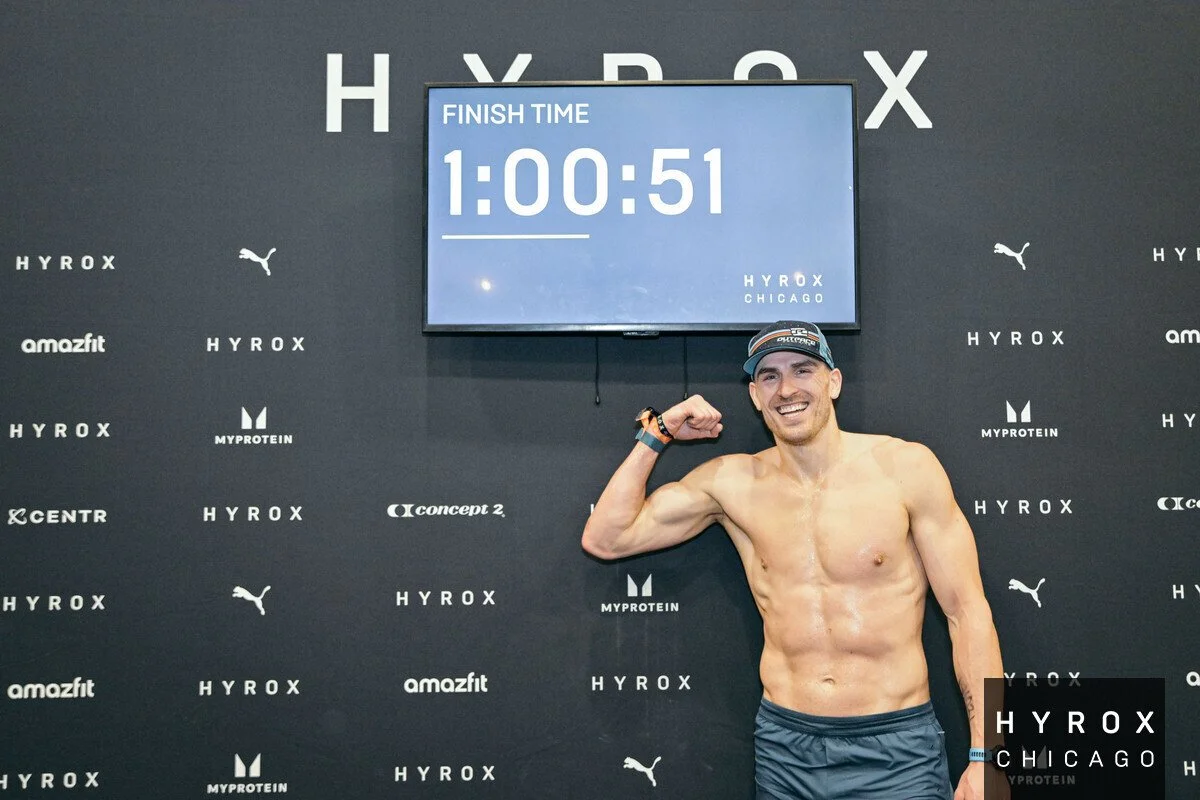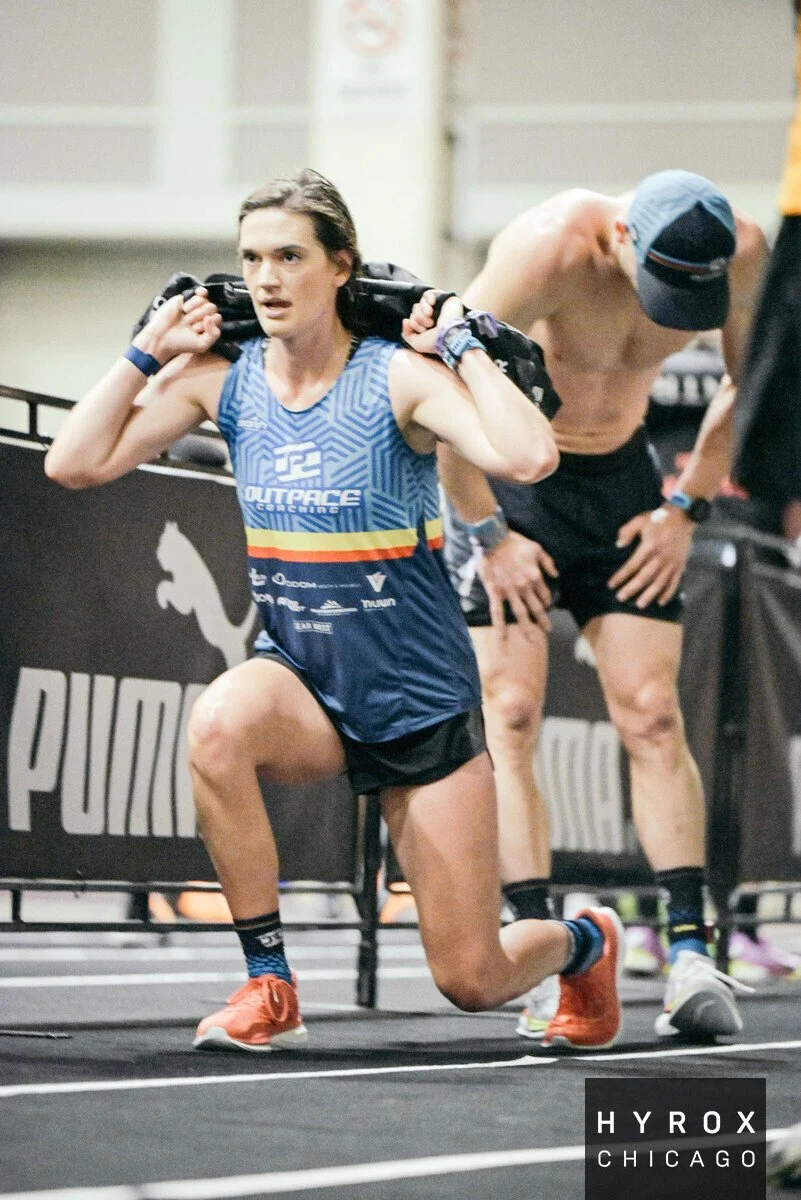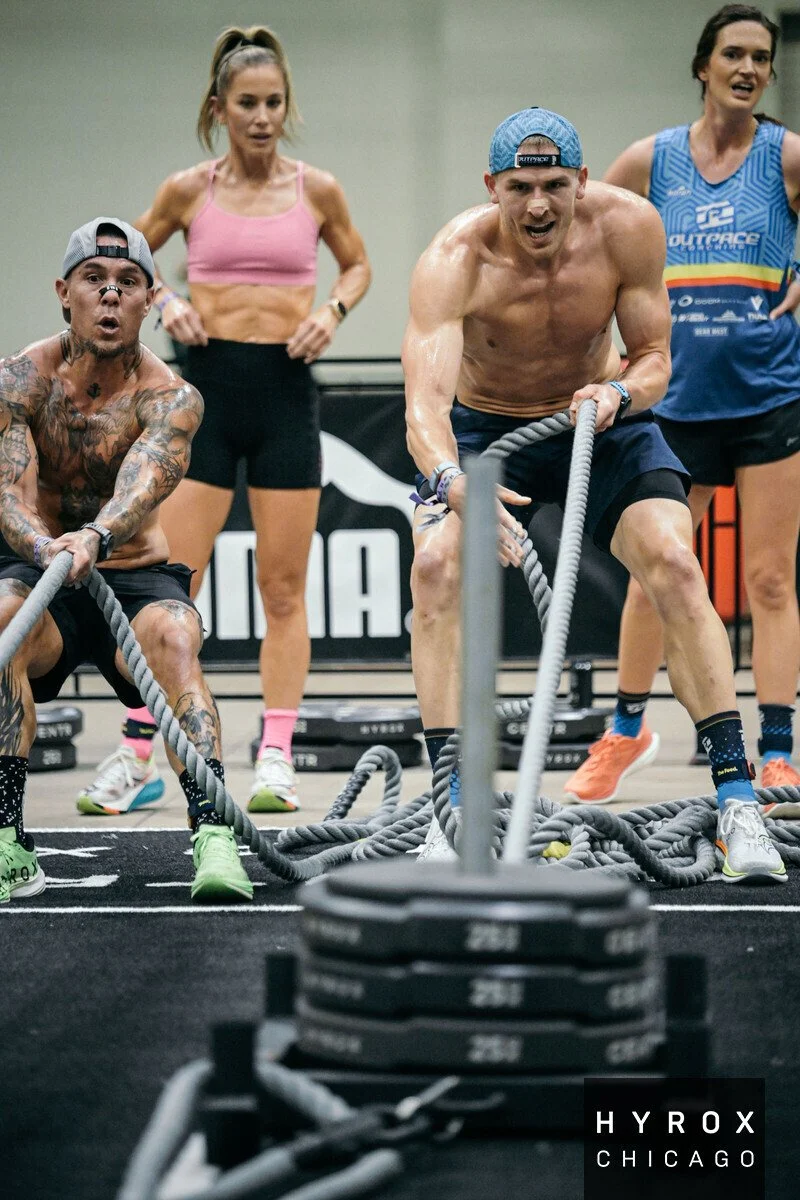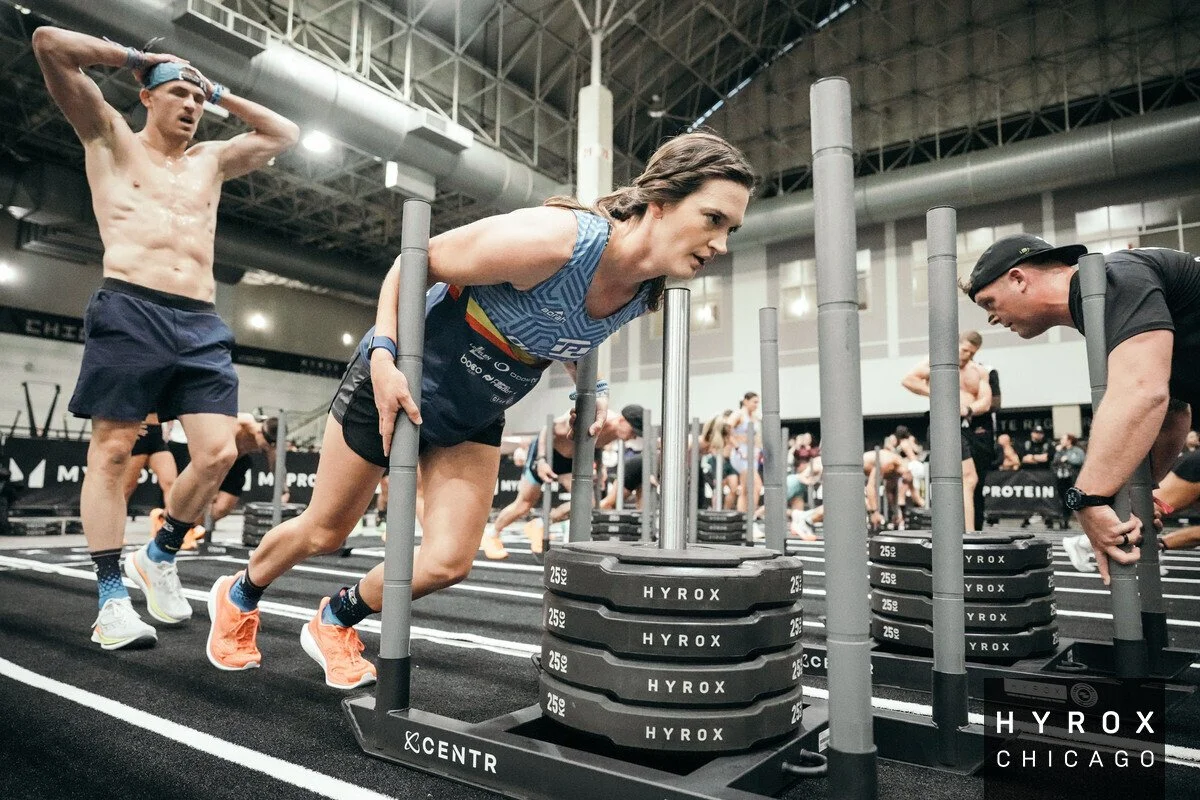HYROX Strategies that helped for a 1 Hour Pro Race
The Hyrox competition is a relatively newer endurance event combining running (8 x 1K run) with functional strength exercises (8 stations). Coach Anthony and OutPace Coaching athletes recently competed in the HYROX Chicago race, and Coach competed in three races in one weekend. Here are some strategies he used in training and during the weekend, to finish in 1 hour time in the fastest wave of the Pro Men’s race, even when it was his third race of the weekend.
Three Areas: Fueling, Training, and Strategy
Men’s PRO Race
Head Coach Anthony with a huge PR compared to World’s earlier this year, and less than two months post Ironman.
FUELING for 3 Races in One Weekend
Most people come to a HYROX event to do one or at most two races. Between the relays, doubles events, and solo races, there are a lot of options among the full weekend, and Coach Anthony decided to race three events: Men’s Pro Doubles on Friday with athlete Nik, Mixed Doubles on Saturday with his wife Deana, and Men’s Pro Solo race on Sunday. For more details on those events, check out this blog post here.
Fueling is a critical piece of training, racing, and recovering. Heading into races, Coach Anthony and his coaching team are passionate about ensuring athletes fuel well and provide recommendations. We typically recommend anywhere from one to three-day carb-loading protocols. For this race, Coach focused on a one-day carb-loading protocol before his first race on Friday, and then focused on recovery fuel immediately post race and throughout the following days.
One day carb-loading before Friday’s race: Consumed 7-8 grams of carbs per kilogram of body weight; focused on drinking carbs as well, like freshly-squeezed orange juice and coconut water. Stuck to carbs that are simple/easily digestible and low in fiber, such as jasmine rice, Rice Chex cereal, bagels, pasta, bananas, and oatmeal.
Post race each day: Had a packet of tart cherry juice to reduce inflammation, a can of sprite to help get simple sugars back in the system quickly and replenish glycogen stores, and a protein shake to help kickstart the rebuild process for muscle recovery.
TRAINING
Coach Anthony isn’t doing as much training as the other men in the fastest wave of the Men’s Pro race. He also completed Ironman Chattanooga with the OutPace Coaching team roughly six weeks before the HYROX races. As a coach he knows that quality is often better than quantity, and he took the same approach in preparing for a strong weekend of racing, nearly qualifying for Worlds again in all three events.
Here were a few workouts that he incorporated into his training that made a positive difference:
Tempo work:
With HYROX consisting of 5 miles of running per event (for a total of 15 miles over the weekend), tempo running helps prepare the body in the following ways:
They raise your lactate threshold (LT)
Hyrox running is done right around (or just above) LT, which is the point where you can run hard but sustainable without blowing up.
Tempo work teaches your body to clear lactate faster and delay fatigue, letting you hold faster paces on all 8 runs.Result: You can maintain your pace even after sled pushes, burpees, and lunges.
They build “fatigue resistance”
In Hyrox you’re never running fresh, and every run starts with some station-induced fatigue. A tempo run forces you to run with a bit of accumulated fatigue and stay composed.
Result: Your legs and breathing don’t fall apart when you run off the sled or after wall balls.
They improve your running economy at threshold
Tempo runs train your body to run efficiently at a moderately hard pace:
smoother stride
better posture
more relaxed breathing
improved rhythm
Result: You spend less energy holding your target race pace, which means more energy for stations.
They improve mental pacing & discomfort tolerance
A tempo run is controlled discomfort, which is the exact skill needed in Hyrox.
It teaches:
calibrating effort
staying calm while working hard
holding yourself together when your legs feel heavy
Result: You avoid early spikes, save energy, and have fewer breakdowns late in the race.
They mimic the “steady grind” of Hyrox
Hyrox isn’t pure speed work; it’s a long, sustained grind with short power spikes.
Tempo runs hit that “grind gear” perfectly: strong, controlled, rhythmic effort.Result: You get better at staying in your aerobic power zone while your heart rate fluctuates from stations.
They allow plenty of quality without overloading your body
Hyrox athletes already lift and do a lot of strength-based stations. Tempos provide high aerobic stimulus with minimal injury risk and low muscle damage.
Result: You get fitter without compromising Hyrox strength sessions.
Hyrox Simulations at 1.5x Distance:
Doing Hyrox simulations at 1.5× the race distance is a strategic way to build capacity, durability, and confidence without needing to “race the race” every week. Here’s why it works so well:
1. They build overcapacity so race day feels easier
If you can handle 1.5× the total volume in training, then the real race (which is shorter) feels controlled rather than overwhelming. This creates a massive buffer on race day:
Lower perceived effort
Less panic and less redlining
Better control of pacing
More energy late in the race
2. They improve fatigue resistance for the later stations
The biggest difference-maker in Hyrox is how well you perform after the halfway point (lunges, wall balls, run 6–8).
Going 1.5× distance builds:
Leg durability
Grip endurance
Cardio stability under fatigue
Better form under stress
When the body regularly experiences deeper fatigue in training, the race’s fatigue feels predictable and manageable.
3. They simulate the “cumulative load” without needing race intensity
1.5× simulations are not full-send. They are “extended grind” sessions. That lets you:
Practice pacing
Practice transitions
Practice fueling
Practice station strategy
Practice mental rhythm
…without blowing up your nervous system like a hard full simulation would. You get race-specific learning without race-level damage.
4. They improve running economy under fatigue
At 1.5× distance, the runs get heavy. Training your stride, breathing, and posture during deep fatigue improves:
Running economy
Mid-race stability
Late-race pace control
This is one of the strongest predictors of Hyrox performance.
5. They build confidence
When athletes complete a 1.5× simulation, their reaction is almost always: “If I can do THAT, I can definitely do a normal Hyrox.” This confidence is huge on race day.
6. They reduce anxiety about the unknown
A full Hyrox at race pace is too taxing to repeat often. But a longer, steadier simulation gives your brain:
familiarity
predictability
pacing clarity
…which removes the mental chaos that crushes performance.
7. They help you discover weak links
Stations like:
sled pull technique
lunge pacing
wall ball breathing
row pacing
burpee cadence
…show their weaknesses more clearly when the entire event is extended. This gives you precise training targets.
RACE STRATEGY
With Coach’s biggest race of the weekend being his third and final race, he had to be smart and strategic. In his mixed double’s race on day two, he did the majority of the strength exercises but was able to run at a slower pace (needing to stick next to his double’s partner throughout the entire event), getting recovery time.
During his Men’s Pro solo race, he tried a couple of new strategies: He went more conservatively on the ski erg (station #1) and row erg (station #5). These two events typically have less variation among athletes, whereas other stations like wall balls, sled pull, and the running, can separate the top finishers from the rest of the competition. By being strategic in those stations, and not going out too fast on the run like many do, he was able to sustain his effort and come away with a big PR.
Going easier on the SkiErg and RowErg helps because it:
prevents HR spikes
this full-body recruitment skyrockets your heart rate faster than almost any station
keeps lactate low
going easier keeps lactate accumulation low enough that your run pace stays smooth and composed instead of “stiff and choppy”
preserves running rhythm
running is the most important part of Hyrox, so protecting your heart rate matters more than gaining 5–10 seconds on an erg
reduces fatigue accumulation
saves far more time overall
keeps your breathing and cadence smooth
your breathing stays under control → your running stays under control
aligns with elite-level pacing strategy
We’re headed to Hyrox Phoenix next! Want to join us?
Many OutPace Coaching athletes participate in a variety of endurance sports throughout the year, such as running, cycling, triathlon, cross country skiing, and more. We can help personalize training to help athletes mix in a Hyrox event into their year and race calendar. Many athletes are trying Hyrox for the first time, and we’ve already had several World Championship qualifiers.
We offer 1:1 coaching, but if you’re interested in just a plan for Hyrox, reach out on our contact form.







